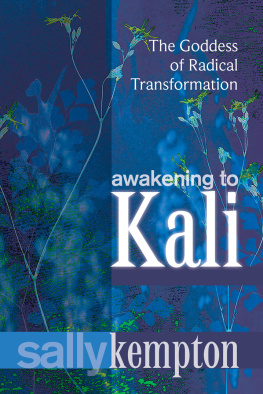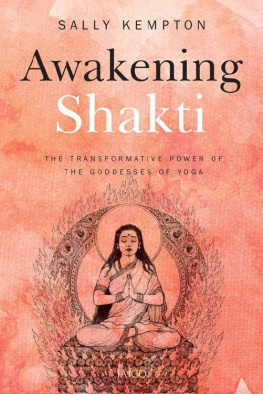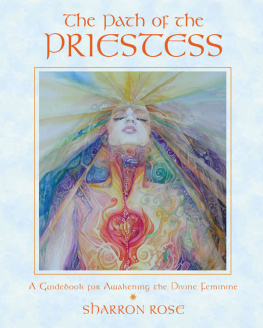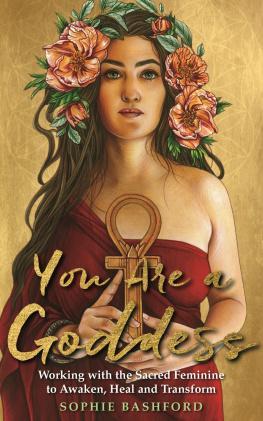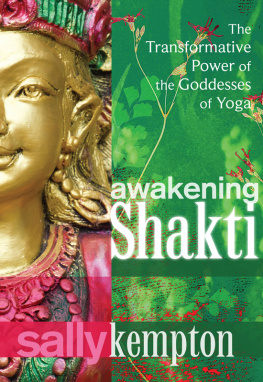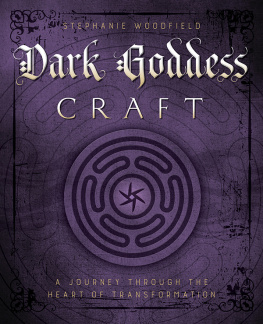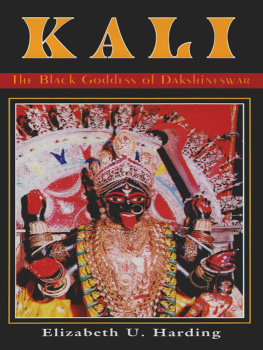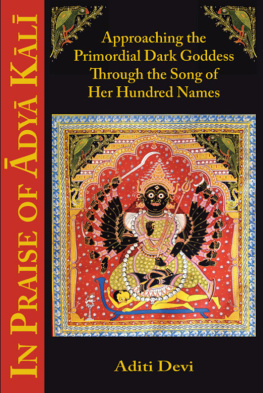Awakening to Kali
The Goddess of Radical Transformation
Sally Kempton
Excerpted from the book
Awakening Shakti: The Transformative Power of the Goddesses of Yoga
Sounds True
Boulder, Colorado
Wild women dont worry.
Wild women dont have no blues.
IDA COX
Contents
1
A Crown of Feminine Design
The Goddess Incarnates
I am the sovereign queen, the treasury of all treasures, whose breathing forth gives birth to all the worlds and yet extends beyond themso vast am I in greatness.
DEVI SUKTA (Praise Hymn of the Goddess) from the Rg Veda
If there is to be a future, it will wear a crown of feminine design.
AUROBINDO GHOSE
ONE OCTOBER NIGHT IN RURAL INDIA, I fell in love with the Goddess. It happened on the second night of a festival called Navaratri, which celebrates the divine feminine as the warrior Durga, slayer of the demons of ego and greed. Like so many festivals in India, Navaratri is both a big party and an occasion for mystical communion with the divine. Women put on their most gorgeous clothes; temples overflow with worshippers. Nights are filled with dancing and storytelling. People have heightened, even visionary, experiences of the energy that the festival invokes.
That night, several hundred of us had gathered amid a blaze of candles next to a huge statue of Durga, eighteen feet high in her red sari, seated on top of a white tiger, arms bristling with weapons. I was supposed to tell one of my favorite mythological tales, the story a romance from one of the goddesses in the Hindu pantheon.
I was thrilled by the opportunity to tell a storysomething I love to doin such a heightened atmosphere. But when I stood up to speak, I was seized by a feeling much bigger than excitement. It was a kind of ecstasy, a deep pulsing joy that nearly undid me while I tried to form the words of my tale. Later, I would learn to recognize this feeling as one of the characteristic signatures of the Goddesss presence. The divine feminine has a thousand names and a thousand moods, but when she chooses to show up for you, she very often shows up as ecstasy.
Ecstasy is a feeling that is hard to convey and impossible to ignore. Every few minutes, I had to stop talking because tears kept threatening to break through my voice. When it was over, I knew that something had just happened which would change my life.
It wasnt just the story that did it. But Ill tell you the story anyway.
Back at the dawn of time, the Great Goddess, who creates the world and then lives as the world, is asked to incarnate as Sati (She-Who-Is) in order to make the sacred marriage with her eternal consort, Shiva. Without her presence, Shiva cannot act in the world. He sits on a mountain, lost in meditation, disdaining to perform his cosmic function. This creates havoc in the cosmos. So, the great deities Brahma the Creator and Vishnu the Sustainer approach the Goddess on their knees. They beg her, for the sake of the world, to take the form of a woman and lure Shiva out of his yogic trance. Daksha, a mind-born son of Brahma, will be her father.
The Goddess agrees, but only on one condition. She has seen that men and gods have begun to treat women as property, lesser creatures in the cosmic hierarchy. If I agree to become your daughter, she tells Daksha, you must promise to honor me as the Great Goddess. If you do not, I shall instantly leave my body, for I will know that the time is not yet right for me to act fully in the world.
Daksha humbly agrees, and Sati is born in his household. At the age of sixteen, she marries Shiva, drawing him out of meditation through the allure of her irresistible beauty and her power of creating bliss. Shiva is the primal outsider of the Hindu pantheon, the lord of thieves as well as yogis. The original shaman as well as the primal yogi, he resides in the deep forests and mountains, attended by ghosts and goblins. He refuses to change his homeless lifestyle just because he has a wife. So for eons, Shiva and Sati make passionate erotic love under trees and beside streams, in subtle realms beyond the clouds, and in secret mountain caves. They adore each other with cosmic passion.
Then the trouble starts. A few thousand millennia have passed. Daksha has worked his way into a position of power as the leading deity of religious orthodoxy. In the process, he has forgotten his promise to the Goddessand forgotten his daughters real nature. He disapproves of Shivas rebel status and feels personally threatened by Shivas obvious disdain for convention. Daksha plans a huge cosmic fire ritual, which will establish for all time the religious structures of the universe. He invites every god, titan, celestial musician, snake deity, and nymph in the universe. But in a fit of celestial malice, Daksha deliberately sends no invitation to his daughter and her consort.
Sati hears the news on the day of the sacrifice. She is stunned beyond measure. Daksha has done the unthinkable. Not only has he grievously insulted her beloved, he has dishonored the World-Mother, the power of life itself, without whom religion is meaningless. Sati knows she cannot remain in a world that does not recognize her. She sits in meditation, summons her inner yogic fire, and sends her life-force into the ether, leaving her body behind.
Shiva goes mad when he finds her. He takes himself to the ritual ground and destroys the sacrifice. He then takes Satis body in his arms and begins to careen through the worlds. Wherever he carries her body, earthquakes and volcanoes, tidal waves and forest fires erupt. At last, the gods do the only thing they can do to save the universe. They send the great wanderer, Saturn, to cut
The story, as I told it, comes from the Shakta tradition, the branch of Hinduism that worships the Goddess as the ultimate reality. In the more traditional version, Shiva is the main figure in the story, and Sati is depicted as a submissive Indian wife who leaps into the sacrificial fire because her husband has been insulted. (In fact, this version has a dark side. It became a model for Hindu widows, who were often encouraged to immolate themselves on their husbands funeral pyre in imitation of Sati.) The Shakta version reveals a far more interesting take on the story. As the Great Goddess Herself, Sati has the power to choose life or to depart it. She doesnt leave her body because her husband is insulted. She leaves because, like so many fathers and the conventional world he represents, Daksha has failed to honor her power and independence. He embodies patriarchys inability to see the primal divinity of the feminine. She leaves because she knows that if the dignity of the feminine is not recognized, true union of the masculine and the feminine is not possible. The story reveals, more clearly than any in Eastern mythology, that moment when the patriarchy removed goddess worship from conventional rituals, leaving the Goddess to hide in the secret places of the earth.
Because the Goddess understands deep time, she also knows that her death is not really an ending, because one day the time will be right for her to reincarnate and once again marry her consort. This time, perhaps, the world will be ready for her.
CONNECTING TO THE ENERGY IN THE MYTH
There is a form of myth that is subversive. This version of the Sati story speaks for a hidden voice within its traditional culture: the voice of primal feminine dignity. Such a powerful myth interacts with the psyche and connects us to the deep structures of the universe. Satis gesture, her willingness to immolate herself to call attention to injustice, called out an answering recognition in me. It had something to do with romance, with the power of doomed love, with Shivas grief, but it was more a recognition of the deep feminine capacity for passion, for feeling itself, for the kind of love that cares nothing for safety or conventional wisdom. That kind of love, I saw, is a quality of the universe itself, which is willing to destroy its own life-forms when the conditions of life become untenable. The divine feminine knows that a birth sometimes demands a death, and that the personal self sometimes has to die if the world is to be made sacred.
Next page
